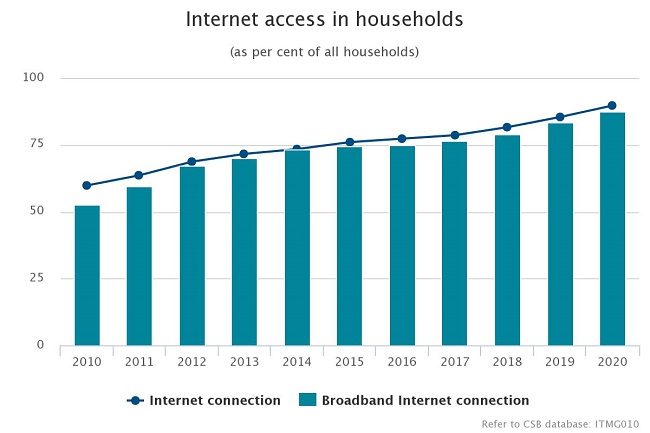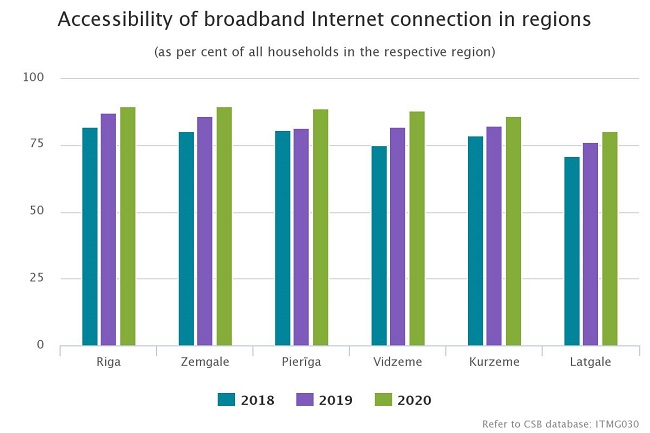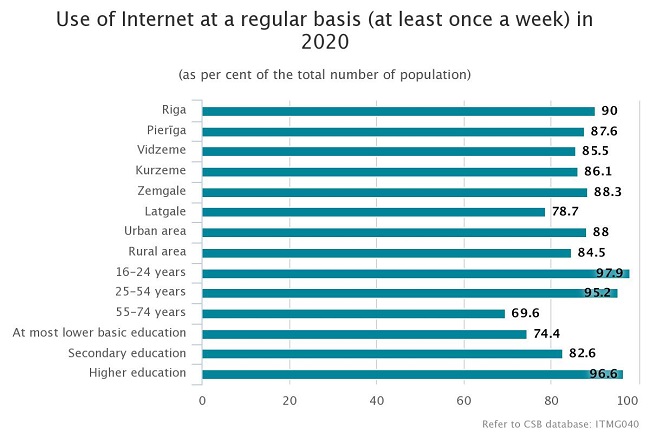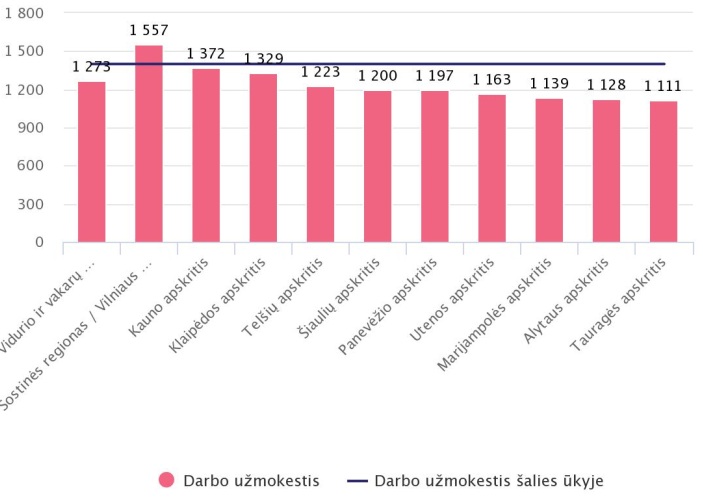Analytics, Internet, Latvia, Society, Statistics
International Internet Magazine. Baltic States news & analytics
Sunday, 21.12.2025, 11:02
89.7% of Latvian households have internet
 Print version
Print version

In 2020, as compared to the previous year, the number of regular Internet users (use Internet at least once a week) increased by 3.2% and reached 86.9%.
The largest share of regular Internet users is in Riga (90%), but the smallest – in Latgale (78.7%). In age group 16-24 years old 97.9% of young people use Internet once a week, in age group 25-54 years this indicator is 95.2%, but in age group 55-74 years – 69.6%.

Population use the Internet for various activities. Most popular of them are internet banking and sending/receiving e-mails, which is used by 85.9% and 85.4% of population, but online news sites/newspapers/news magazines are read by 81.7% of population. Males more commonly play games online than females (26.3% and 16.5%, respectively), but females – search online for health-related topics more than males (63.3% and 46.4%, respectively). Searching for health-related topics shows the largest differences between urban and rural population – 59.2% of urban population indicated that used Internet for such purpose, while share of such rural population is 46.8%.
Most popular activities of 16-24 years old young people, compared to 2019, have not changed. They include participating in social networks, sending messages in texting apps and sending/receiving e-mails. Most popular activities of 65-74 years old seniors include reading online news sites/newspapers/news magazines, internet banking and sending/receiving e-mails.
Storage of documents, photos, music, videos or other files in data storage on the Internet (clouds) is another popular purpose of Internet use, which is used by 34.2% of Internet users, especially pupils and students, of which more than a half (59.6%) indicated that Internet is used for such purpose.\
In 2020 contacting or interacting with public authorities or public services over the Internet by individuals continues to increase. 63.4% of population submitted completed forms to public authorities websites, and during a year this indicator has risen by 7.9%.
To purchase goods and services, Internet was used by 62.8% of population2, and, compared to 2019, this indicator rose by 9 %. One of the reasons for such significant growth were restrictions related to emergency situation implemented to prevent spread of COVID-19, in the result of which population made less face-to-face purchases but used Internet more. Mostly population3 used Internet to purchase clothes, shoes or accessories (45.4%), computers, tablet computers or mobile phones and accessories (28%), electrical equipment or household appliances (27.8%). Delivery of food from restaurants or other catering enterprises was used by 17.9% of population in 2020, but food or drinks from stores or packaged food vendors – by 12.3%.
Significant aspect of use of nowadays Internet is protection of individual privacy. In 2020, 51 % of population indicated that before giving personal details over the internet they read privacy policy, but 39.2% didn't want to provide information on their location, and 36% refused from use of their personal information for advertising purposes. When participating in social networks, 35.1% restrict access to their social network profile. Majority of population (66.3%) know that cookies may be used to offer Internet users personalised advertisements and 63% indicated that this fact bothers them a bit. In turn, 26.5% indicated that they have changed their Internet browser settings to restrict cookies.

79.3% of Latvian population use smartphone for personal purposes. More than a half of them (55.2%) have also security software installed on their smartphones along with operating system, for example, anti-virus, anti-spam software, firewall, but 8.2% of them indicated that they have installed such kind of software themselves. 90% of smartphone users indicated that they have not experienced loss of information, documents, pictures, or other data on the smartphone due to malicious software.
In 2020 for the first time questions of the use of Internet of Things was included in the survey. The results obtained show that Internet of Things, interchangeably connected devices, or systems that may be monitored or remotely controlled using the Internet, is an emerging technology in Latvia and currently is not widely used. Alarms, smoke detectors, surveillance cameras, door locks or other security systems connected to the Internet were used by 4.3% of population, virtual assistant as a type of smart speaker or application – by 4% of population, while internet-connected devices regulating energy (thermostats, energy meters, lamps, switches), as well as internet-connected household appliances (refrigerators, stoves, coffee machines) – by 3.4% of population.
Survey on the use of information and communication technologies in households was carried out at the beginning of 2020 with co-financing of the European Union. Aim of the project is to acquire qualitative and internationally comparable statistical information on the use of Internet, and it covered 5 118 individuals aged 16 to 74 years.
- 28.01.2022 BONO aims at a billion!
- 25.01.2021 Как банкиры 90-х делили «золотую милю» в Юрмале
- 30.12.2020 Накануне 25-летия Балтийский курс/The Baltic Course уходит с рынка деловых СМИ
- 30.12.2020 On the verge of its 25th anniversary, The Baltic Course leaves business media market
- 30.12.2020 Business Education Plus предлагает анонсы бизнес-обучений в январе-феврале 2021 года
- 30.12.2020 Hotels showing strong interest in providing self-isolation service
- 29.12.2020 В Латвии вводят комендантский час, ЧС продлена до 7 февраля
- 29.12.2020 В Rietumu и в этот раз создали особые праздничные открытки и календари 2021
- 29.12.2020 Latvia to impose curfew, state of emergency to be extended until February 7
- 29.12.2020 18-19 января Наталия Сафонова проводит семинар "Управленческий учет во власти собственника"








 «The Baltic Course» Is Sold and Stays in Business!
«The Baltic Course» Is Sold and Stays in Business!

